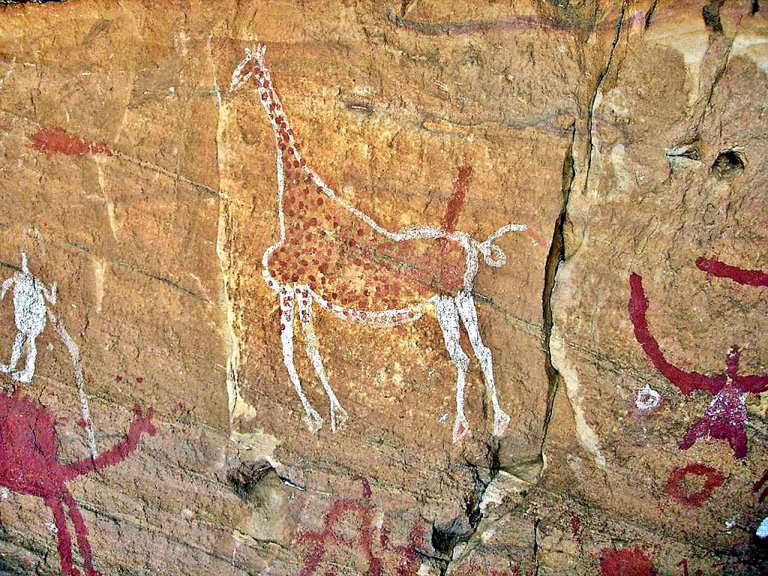 Crossed by the Tropic of Cancer 80 km north of Tamanrasset, the Hoggar (Tamachek Ahaggar) covers an area of about 540 000 km2, a quarter of the total area of Algeria.
Crossed by the Tropic of Cancer 80 km north of Tamanrasset, the Hoggar (Tamachek Ahaggar) covers an area of about 540 000 km2, a quarter of the total area of Algeria.
East of Tamanrasset rises the platform of the Atakor, a staggering landscape where lava fields hold a large place, where the altitude is everywhere over 2 000 m and on which the dismantled volcanoes make projections flush with the 3,000 m.
Its highest peak, Mount Tahat in the center of Atakor, rises to 2 918 meters and dominates Algeria.
The most famous site of the Hoggar, sung by many poets and novelists, is the Assekrem, 80 km from Tamanrasset as the crow flies and easily accessible by track. The Assekrem hosted the summer hermitage of Charles de Foucauld, who settled there in 1911.
A true desert of stones, the Hoggar is essentially composed of volcanic rocks.
Erosion has shaped an astonishing landscape while sharp peaks. Because of a less extreme climate than the rest of the Sahara, the Hoggar is an important refuge for certain animal and plant species. From an ecological point of view, it can be differentiated from the rest of the Sahara.
The Hoggar Massif is also the country of the Tuaregs called Kel Ahaggar.
Near the town of Tamanrasset, in the oasis of Abalessa, it is possible to find the tomb of Tin Hinan, an ancestor matriarch of the Tuaregs of Hoggar. According to legend, Tin Hinan comes from Tafilalet, in the Atlas Mountains, Morocco.
The immensity of these expanses of stones, the staggering beauty of this volcanic relief, with its screes of basalt and porphyry, invite mystical contemplation. Following the example of Charles de Foucauld, Christian hermits have long lived in the stone huts of the Hoggar.
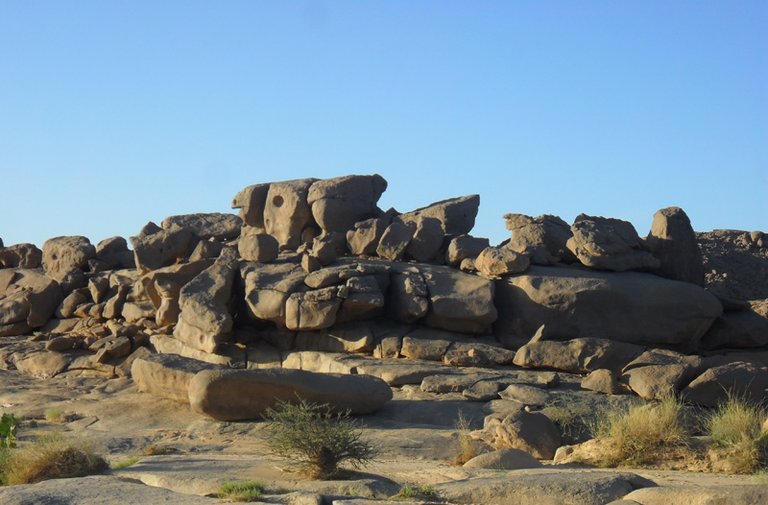
Tamanrasset
Tamanrasset, or "Tam" as the men of the North call it, is the undisputed capital of the Hoggar. This relatively young city benefits from the relatively temperate climate of the altitude, at nearly 1,400 meters. The red and original houses, the magnificent panorama make of this city a particularly endearing place, which remembers its visitors. Foucault's father also left an indelible mark with his Bordj, near the Museum of traditional arts, rich in beautiful crafts: jewelry, clothes, weapons and even locksmith. The city market is also very attractive with its belt shops and vendors at the auction.
A few kilometers away is a thermal spring, Adriane, very busy. Nearby in the village, which has many blacksmiths, are two unique funerary monuments. They house the tombs of Prince Moussa Ag and his cousin Dassine Ould Khemma, famous in local mythology.

The Ahaggar National Park
Created in 1987 and declared World Heritage of Humanity, the park covers 80% of the massif with its 450 000 km2. The landscapes are more dazzling than others. In Arak, sources of drinking water spring up into the canyon, feeding on vegetation that contrasts with the lunar landscape. In Tadjmount, a ferruginous spring paves the way for a long parade of elephants, sheep, dogs, hippos on calcined rocky ground.
The Tropic of Cancer goes to In Ecker, just in front of the black and cut Tadefest and the surprising Ghar El Djenoun.
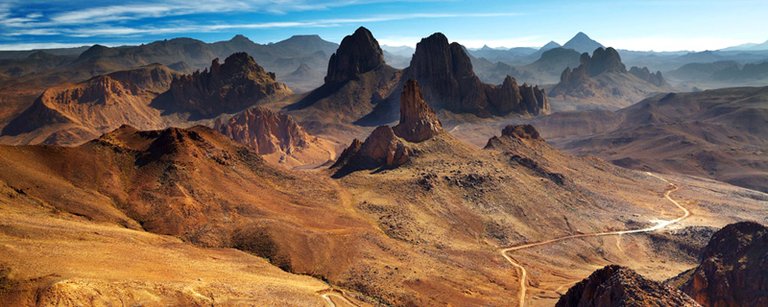
The circuit of Assekrem
Privileged destination, great classic of the essential Saharan tourism, the visit of the plateau of Assekrem is essential, waiting for you since the dawn of time.
The show is incomparable
above rocky peaks, needles and sharp edges to infinity. This journey that takes you to the Hermitage requires two days at least. Two days of happiness to go along the Ilharen, let the thermal spring of Tahabort to the southwest and make a stop at the Gueltas of Imlaoulaouene. Temple of water in the middle of a tortured landscape, these cascades of 20 meters high, The panoramic view is superb, the look is lost to infinity.
To the north culminates the imposing Tahat. This is the last step towards the refuge of Father de Foucauld.
This hermitage, built in 1910, houses a beautiful little chapel.
Here, mineral and spiritual communicate with force, silence is presence;
meditation and transcendence become essence.
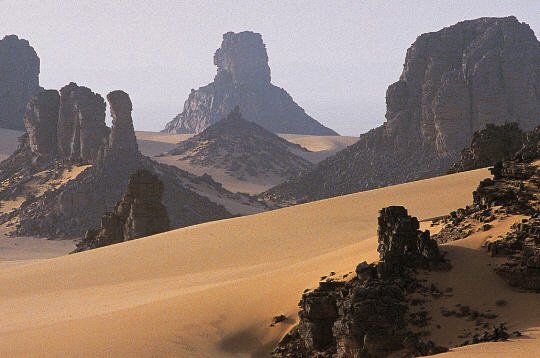
The Tassili n'Ajjer
Eastern part of the Saharan Massif Central, the Tassili n'Ajjer is a sandstone plateau in an arc of 1,500 to 1,800 m high, inclined to the north and east, a vast plain of 500 to 800 m altitude, infra-Tassilian furrow, separates from the massif of the Ahaggar. This lower part is the domain of ergs whose most important is the erg of Admer.
Narrow laces, called akba, where one circulates in the middle of dizzying dizziness for long hours and where, most often, only men and donkeys can venture, give access to the summit. The best known ones, those of Tafelalet and Aghoum, lead to the famous sites of Tamrit and Sefar for one, Jabbaren for the other. North of Djanet, the pass of Assakao, less abrupt, is accessible to camels.
At the top, a fabulous landscape made of thousands of gigantic columns pressing against each other, evoking castles, cities in ruins, sometimes forming real forests of stones, is offered to the view. At the base of these columns, alveoli have served as shelters for prehistoric populations and are still frequently used.
Their walls are often covered with paintings evoking populations that have succeeded each other for more than 10,000 years.
Its geological formations, its rock art, by their richness, their diversity earned the Tassili N'Ajjer an inscription on the list of the sites of the World inheritance in 1982.
But beyond its immeasurable archaeological wealth, the Tassili deserves to be discovered differently because it has the merit of being all deserts at once. From the mineral Tassili to the fantastic Tadrart, from the Erg Admer to the beautiful dunes to the wadi Djerat where the first paintings were observed, your passage in this region will transform you for life.
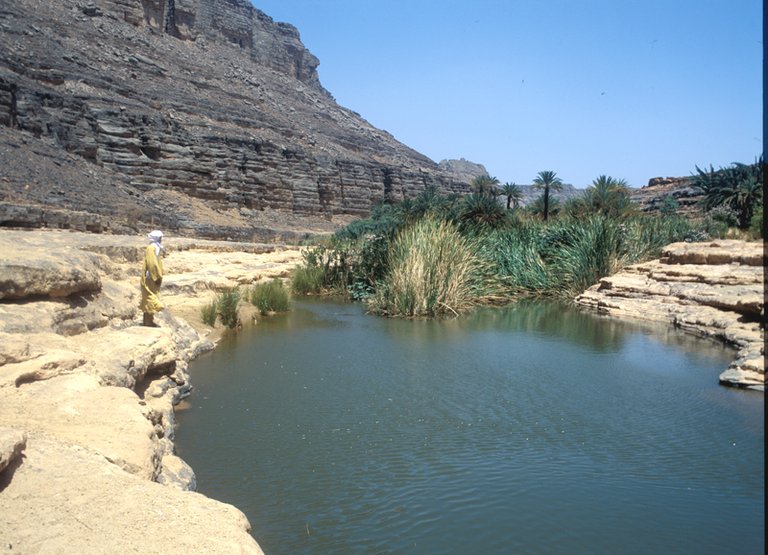
Djanet With its three ksour and quarters suspended above the wadi Idjeriou (the sea), Djanet is an oasis full of charm, endowed with a beautiful palm grove.
But Djanet is especially the healthy stop before the climb to Tassili. This magnificent ascent through the steep trails - the motorized trails stop at the foot of the plateau - and full of mysteries will enchant you. The circuits are multiple and allow you to cross the plateau on foot through the necklace of rock stations of Tamrit, In Itinen, Sefar, Tin Tazarift, Jabbaren, In Aouanret.
You will be amazed by the mystery and grace that emanate from these paintings. Frescoes of hunting scenes from the so-called "Bovidian" era (6th century), horse antelopes at Tamrit; Painted gods "Round Heads" alongside elephants and "Pretty women on luxuriously harnessed oxen", as described by Lhote in In Itinen; "God with prayers" 3 meters high hidden from view, in the depths of the gorge leading to Sefar; archer and reclining woman from the bovine period in Tin Tazarift; characters with dancing horns and great Martian god in Jabbaren or white lady of In Ouanrhat, painted in particular ocher. So many worlds are available to you in the Tassili, gigantic open air museum!

La Tadrat In a fabulous maze of orange-yellow dunes and rocks with delicate shapes chiseled by erosion and easily identifiable, this region extends south of Djanet, before the border with Niger. The tour begins with the Imaharten parade (rock carvings), a natural cleft in the Tassili, before the In Djaren canyon gate, then the fabulous Tamezguida arches, so often photographed. Then comes the labyrinth of orange dunes and fairy chimney Moul'Aga, thenTin Merzouga
I would never die for my beliefs because I might be wrong.
magic place, I would like to be there
yes, it is a beautiful region, I wish you to go there one day
Hi! I am a robot. I just upvoted you! I found similar content that readers might be interested in:
http://tourismfromalgeria.blogspot.com/
Congratulations @itatchi! You received a personal award!
You can view your badges on your Steem Board and compare to others on the Steem Ranking
Vote for @Steemitboard as a witness to get one more award and increased upvotes!